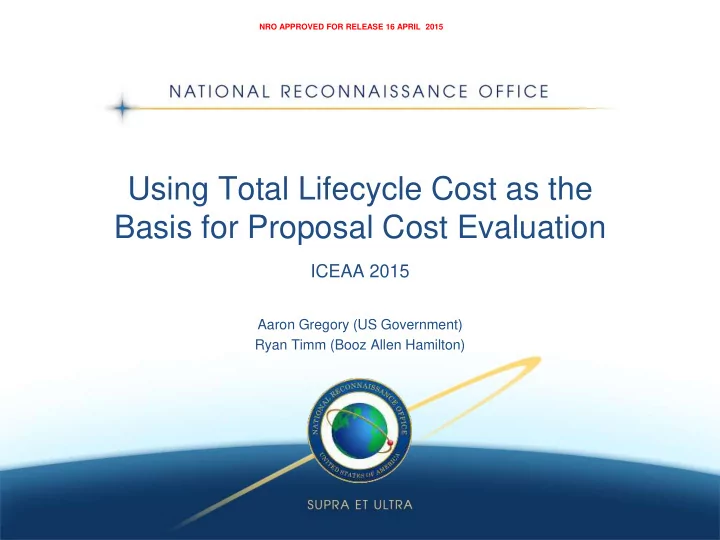

NRO APPROVED FOR RELEASE 16 APRIL 2015 Using Total Lifecycle Cost as the Basis for Proposal Cost Evaluation ICEAA 2015 Aaron Gregory (US Government) Ryan Timm (Booz Allen Hamilton)
UNCLASSIFIED About the NRO The National Reconnaissance Office (NRO) is: The national program to meet the U.S. Government's intelligence needs through spaceborne reconnaissance A Department of Defense (DoD) agency and an element of the Intelligence Community Funded through the National Intelligence Program and the Military Intelligence Program portions of the federal budget The NRO’s existence was declassified by the Deputy Secretary of Defense on September 18, 1992 NRO CAAG 2
UNCLASSIFIED Overview Total Lifecycle Cost (TLCC) Case Study Benefits of TLCC approach to source selection Challenges of TLCC Overcoming TLCC Challenges NRO CAAG 3
UNCLASSIFIED Typical Government Source Selection Detailed requirements define the product or service the government wants delivered Government reference architecture is often provided to instruct the contractor on how they want the system designed Maintenance costs of system may or may not be considered Cost evaluation uses the contractor’s bid price adjusted to determine most probable cost NRO CAAG 4
UNCLASSIFIED Source Selection Using TLCC High level requirements and a Statement of Objectives define the product or service the government wants delivered Contractors may be given freedom to propose new innovative architectures Cost evaluation includes: Contractor’s bid price adjusted to determine most probable cost Maintenance for the system Operations Legacy sustainment until transition Impacts to government furnished equipment / IT infrastructure Impacts to other systems / interfaces NRO CAAG 5
UNCLASSIFIED Case Study: Space Vehicle Ground System Government seeks to consolidate stove-piped Space Vehicle ground systems in order to reduce costs through Consolidated O&M Extensibility to future Space Vehicles (SVs) Space Vehicle System 1 Space Vehicle System 2 Space Vehicle System 3 Tasking Tasking Tasking Mission Management Mission Management Mission Management Command and Command and Command and Control Control Control Mission Processing Mission Processing Mission Processing Dissemination Dissemination Dissemination NRO CAAG 6
UNCLASSIFIED Typical Ground System Components Space Vehicle: Electro-Optical SV Ground Terminal: The direct interface with the space side of things Tasking: User requested images of points or areas Tasking on earth Mission Mission Management: Evaluates collection Management opportunities and develops SV schedule Command and Command and Control: Turns schedule into SV Control commands manages SV state Mission Processing: Receives data and develops Mission Processing image products Dissemination: Distributes image products to users Dissemination NRO CAAG 7
UNCLASSIFIED Case Study: Space Vehicle Ground System User Tasking Management Task Sat Comm resource requests, status Mission Control System Collision Avoidance Mission Space Cmds Management Communications Vehicle System GPS data Provided Tlm GPS Ground Command SW and Control Cmds Operations Tlm Weather & Weather Environmental Data Mission Wideband Data and Stored Telemetry Processing NRO CAAG 8
UNCLASSIFIED Benefits of Using TLCC in Source Selection Innovation – enables novel architectures to be proposed by contractor Identifies hidden / unforeseen costs such as external interface modifications Identifies costs regardless of directorate or agency to which they are attributable Identifies costs to the government for Operations and GFE that are not part of the contract Enables inclusion of costs for future requirements that are not part of the initial bid NRO CAAG 9
UNCLASSIFIED TLCC Estimating Challenges Legacy sustainment through transition Existing sustainment contracts may not run until transition date Maintenance effort will likely be reduced when system is being replaced due to eliminating enhancements and low priority bug fixes Contractors may attempt to game TLCC based on unreasonably aggressive transition schedule Incumbent contractor has advantage if their legacy system has high sustainment costs Contractors may not adequately scope effort not on contract SV Provided HW, Operations, Interface modifications, GFE Contractor may propose cost effective operations that are unlikely to be adopted Operations staffing / automation Policy considerations NRO CAAG 10
UNCLASSIFIED Overcoming TLCC Challenges Legacy sustainment through transition Independent schedule analysis and adjustments based on historical data ESLOC / Man Month Launch support and initialization timelines Contractors may not adequately scope effort not on contract Identify range of historical software sizing by software functional components Identify historical costs for external interface modifications Independently evaluate GFE costs based on historical data Contractor may propose cost effective operations that are unlikely to be adopted Adjust contractor proposed operations to reflect likely government Concept of Operations NRO CAAG 11
UNCLASSIFIED Conclusion TLCC enables innovation in contractor proposals Enables decision making through insight on enterprise costs Requires cost estimation support to source selection team Requires historical cost, schedule, and sizing data to build defensible estimates that could withstand protest NRO CAAG 12
UNCLASSIFIED Questions? Aaron Gregory NRO CAAG gregorya@nro.mil (571) 304-8852 Ryan Timm NRO CAAG Support Booz Allen Hamilton Timm_Ryan@bah.com (571) 304-8853 NRO CAAG 13
14
Recommend
More recommend